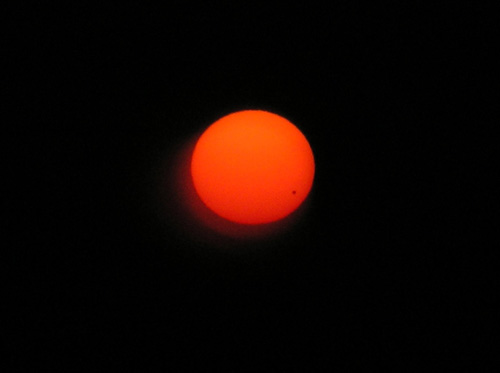
Sure, you can see the sunset from the U of G observatory atop the MacNaughton Building. But next month, you can also watch Venus make a rare pass directly in front of that setting sun.
The so-called transit of Venus will be the highlight of a “planet-gazing” evening at the MacNaughton observatory June 5, to be led by physics emeritus professor Bob Brooks. He will also discuss the scientific and historical importance of the rare event as part of Alumni Weekend in mid-June.
As the second-closest planet to the sun, Venus travels at an angled orbit that normally crosses above or below the sun from our perspective. Roughly once a century, the planet passes directly between the Earth and the sun.
Each transit is actually a pair of transits eight years apart. The last one occurred in 2004, when Brooks also hosted a morning planet-gazing event.
Before that, the previous Venus-sun tango happened in 1874 and 1882. Anyone looking for the next pair of transits will have to wait until 2117 and 2125.
In a full or partial solar eclipse, the moon passes between the sun and the Earth, causing the sky to darken during the transit. Although Venus dwarfs the moon, it is much more distant. So its six-hour crossing will cause no noticeable darkening on Earth, says Brooks.
The six-hour transit will begin just after 6 p.m. (Viewers in Hawaii will get the best view.)
Eight years ago, Brooks captured images of the transit on a hazy morning from atop MacNaughton. What did it look like? “Imagine if the sun were a basketball. Venus would be a marble against it,” he says.
For him, part of the event’s appeal lies in its historical and scientific importance.
As far back as the 17th century, Johannes Kepler had realized that the transit could be predicted. Early astronomers – including James Horrocks and Edmund Halley (of Halley’s Comet fame) – either saw the transit in the 1600s or predicted that it could be used to measure the size of the solar system.
Later astronomers tried to use the event to gauge the distance from Earth to Venus by timing the transit from two widely separated points. From that information, they hoped to infer the size of the entire known solar system. “They were reasonably successful using the transits of 1761 and 1769,” says Brooks.
By the late 1800s, astronomers had used Mars as a measuring stick to estimate distances between the sun and the planets. “That gave us a good idea of the size of the solar system by the time the next transit of Venus came around.”
Still, he finds this summer’s event something to marvel at. “To be able to see the disc of a planet against the disc of the sun and know that we can predict it within seconds is amazing. To lose our sense of wonder about something like that would be sad.”
Named for the Roman goddess of love and beauty, Venus is the brightest object in the night sky next to the moon. Earlier this year, it drew Earth-bound eyeballs because of its alignment with Jupiter and the moon.
The MacNaughton observatory can accommodate about 40 visitors. Brooks hopes to use a webcam to capture the transit June 5. (He reminds viewers never to look directly at the sun without special filters.)